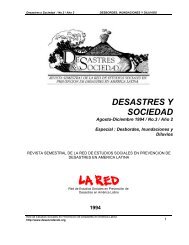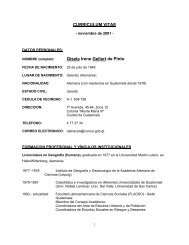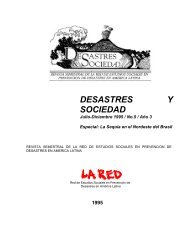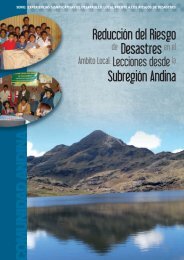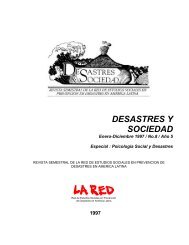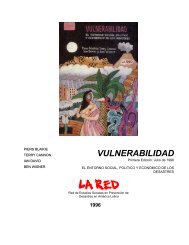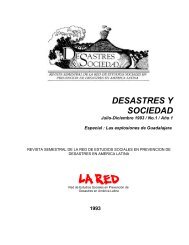Estrategias sociales de prevención y adaptación Social ... - La RED
Estrategias sociales de prevención y adaptación Social ... - La RED
Estrategias sociales de prevención y adaptación Social ... - La RED
Create successful ePaper yourself
Turn your PDF publications into a flip-book with our unique Google optimized e-Paper software.
If no floods have occurred for a very long time, the floodplain as attractor becomes ever<br />
more alluring. Floodplains, which are prime locations for resi<strong>de</strong>ntial and commercial <strong>de</strong>velopments<br />
and reduce transport costs, are rediscovered as profitable investment sites for housing<br />
and other human land uses, an individualist rationality.<br />
The 2008 Delta Plan, a follow up to the 1953 plan to prepare for a climate–proof future,<br />
again had nothing to say about spatial planning: the sea may rise by up to 1.35m in the next<br />
two sentences, but Dutchmen can build wherever they want as long as the dikes and dunes<br />
keep them safe. flying in the face of apparent reason, the Dutch planned a new housing <strong>de</strong>velopment<br />
project was planned at one of the country’s lowest spots, well below sea level in the<br />
quaint town of Gouda, just because they can. Since the lifting of the ban on building in floodplains,<br />
zoning has become a no-no.<br />
Should a new flood catch the Netherlands unawares, however, a new cycle is likely to<br />
start, with new incarnations of predictable social, economic and technical responses. The<br />
below gives a rundown of the latest set of what are now promoted as “best practices”.<br />
Reviving and Surviving Best Practices<br />
Egalitarianism: Back to <strong>Social</strong> Resilience. Cross-cutting the technological and managerial<br />
practices are the overall pattern of water governance.<br />
In current policy folklore, we are currently moving from “government to governance”.<br />
Likewise in the Netherlands water management is held to be “traditionally” top-down. <strong>Social</strong><br />
resilience and spatial adaptivity can be expected to be low in the Netherlands due to the<br />
infrastructural investment fixing rather than moving with the water.<br />
However, a closer look at history reveals that farmers, monks and businesses have taken<br />
the lead long before the state took over a big chunk, and that public dominance in this has<br />
only recently peaked, from the 1953 flood until the early 1990s, a time when <strong>de</strong>centralisation<br />
and liberalisation took hold of the Netherlands.<br />
In addition to local and regional water managers, civil charity continued to play a prominent<br />
role in flood management in the period leading up to the French occupation (1798-<br />
1806). “A blend of emergency and reconstruction aid in which civil charity, central state<br />
involvement and the contribution of the Dutch kings mobilised a whole nation in times of<br />
calamitous flood disasters.” Flood relief only gradually came to be nationalised in the<br />
Netherlands between 1740 and 1861, the latter half coinciding with what Lintsen (2002).<br />
Calls the “authoritarian period” in Dutch flood management.<br />
Since the Delta works, finalised the 1980s, the Dutch have <strong>de</strong>pen<strong>de</strong>d on the government<br />
and technology to take care of their security. Until 1994 however, Dutch regions did not<br />
even have evacuation plans, believing floods would never happen again. After the 1995 highwater<br />
event, the Delta <strong>La</strong>w temporarily gave the public sector extra powers. In 2003 the centre-right<br />
Dutch government however <strong>de</strong>ci<strong>de</strong>d it would not be 100% responsible for floods. In<br />
2006, and again in 2009, it called for self-reliance (zelfredzaamheid). The government<br />
would now facilitate social self-help in disaster events. Awareness campaigns remain ambiguous<br />
and exclusively focussed on households. So-called safety regions however are re-establishing<br />
contact with civil society.<br />
31





